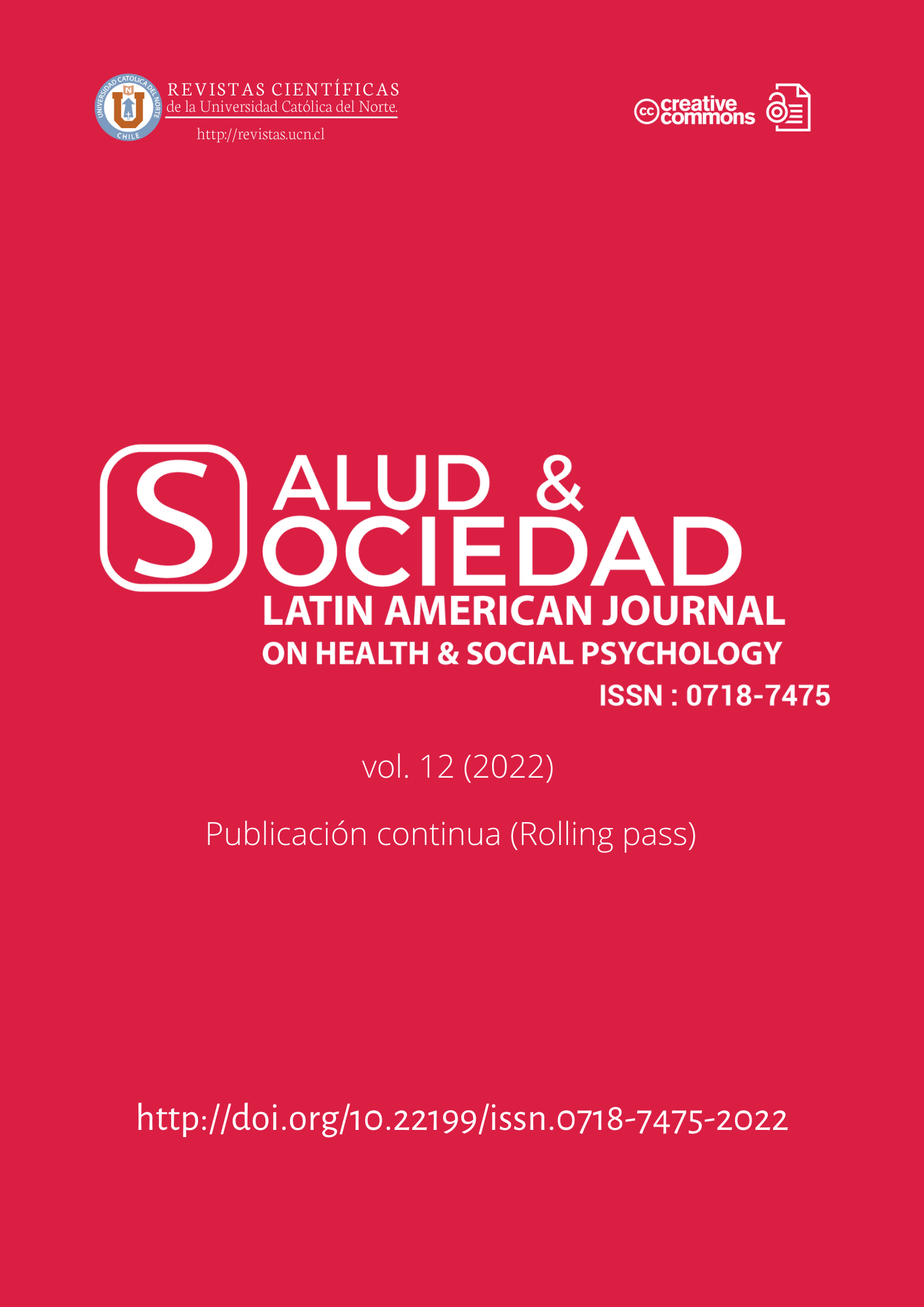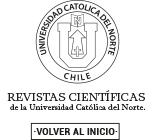Relación entre el estrés, la violencia de pareja y la satisfacción diádica en una muestra de personas adultas jóvenes en Puerto Rico
DOI:
https://doi.org/10.22199/issn.0718-7475-4760Palavras-chave:
estresse, violência no namoro, satisfação diádica, jovens adultosResumo
CONTEXTO: Muitos adultos jovens experimentam altos níveis de estresse e estão expostos a comportamentos de risco, como uso de drogas e álcool, e sexo desprotegido. OBJETIVO: Conhecer a relação entre estresse, violência por parceiro íntimo e satisfação diádica em uma amostra de jovens de baixo nível socioeconômico. MÉTODO: Foi realizado um estudo descritivo-correlacional por meio do desenho de questionário na internet. Participaram 236 pessoas, a maioria mulheres (81,4%) com idades entre 18-30. RESULTADOS: Encontramos uma relação negativa, embora não significativa, entre estresse e satisfação diádica (rτ = -. 06, p> .05), uma relação positiva e significativa entre estresse e violência conjugal (rτ = .19, p <.001 ), e uma relação negativa e significativa entre violência por parceiro íntimo e satisfação diádica (rτ = -.21, p <.001). A análise de mediação mostrou um efeito indireto significativo do estresse na satisfação diádica, por meio da violência conjugal (b = -0,15, IC BCa [-0,26, -0,07]). CONCLUSÕES: Os resultados sugerem que essa população apresenta altos níveis de estresse e está mais sujeita a se envolver em comportamentos violentos com seus parceiros, o que tem impacto na diminuição da satisfação diádica.
Downloads
Referências
Adrián Brito-Tinajero, C., Leonor, Y., & Delgadillo-Guzmán, G. (2016). Relación entre violencia de pareja y estrés parental en población mexicana Relationship among domestic violence and parental stress in Mexican population. Revista Del Centro de Investigación Universidad La Salle, 12(45), 91–106. https://bit.ly/3JVXerg
American Psychological Association. (2021). Stress in America: One year later, a new wave of pandemic health concerns. apa.org
BBC Mundo. (2017, May 3). Puerto Rico se declara en quiebra para reestructurar su multimillonaria deuda. BBC. https://bbc.in/3dwuut5
Cabrera García, V. E., Herrera Calle, L. E., & Serrato Vásquez, C. (2019). Importancia de la diferenciación de sí mismo y el ajuste diádico en la explicación de la estabilidad marital. Revista Colombiana de Psicología, 28(1), 65–80. https://doi.org/h8br
Caceres, J. (1996). Manual de terapia de pareja e intervención familiar. Fundación Universidad-Empresa.
Contreras, P., Guzman, M., Alfaro, C., Arraya, C., & Jiménez, P. (2011). Significados asociados a la infidelidad en estudiantes universitarios con estilos de apego seguro e inseguro. Salud & Sociedad, 2(1), 10–30. https://doi.org/h8bs
Cordero, V., & Teyes, R. (2016). Resiliencia de mujeres en situación de violencia doméstica. Omnia, 22(2).
Cullen, M. R., Baiocchi, M., Eggleston, K., Loftus, P., & Fuchs, V. (2016). The weaker sex? Vulnerable men and women’s resilience to socio-economic disadvantage. SSM - Population Health, 2, 512–524. https://doi.org/ghd9r8
del Pilar Sánchez-López, M., & Dresch, V. (2008). The 12-Item General Health Questionnaire (GHQ-12): Reliability, external validity and factor structure in the Spanish population. Psicothema, 20(4), 839–843.
Estudios Técnicos, I. (2017). Preliminary estimate: Cost of damages by Hurricane María in Puerto Rico. https://bit.ly/2HXexqo
Fry, R., Passel, J. S., & Cohn, D. (2020). A majority of young adults in the U.S. live with their parents for the first time since the Great Depression. https://pewrsr.ch/3ArR8Me
García, F. E., Fuentes Zarate, R., & Sánchez Sánchez, A. (2016). Amor, satisfaccion en la pareja y resolucion de conflictos en adultos jóvenes. Ajayu Órgano de Difusión Científica Del Departamento de Psicología UCBSP, 14(2), 284–302.
Goldberg, D. P., & Hillier, V. F. (1979). A scaled version of the General Health Questionnaire. Psychological Medicine, 9(1), 139–145. https://doi.org/frrnvr
Guil, R., Zayas, A., Gil-Olarte, P., Guerrero, C., González, S., & Mestre, J. M. (2016). Bienestar psicológico, optimismo y resiliencia en mujeres con cáncer de mama. Psicooncologia, 13(1), 127–138. https://doi.org/h8bt
Howland, M., Armeli, S., Feinn, R., & Tennen, H. (2017). Daily emotional stress reactivity in emerging adulthood: temporal stability and its predictors. Anxiety, Stress and Coping, 30(2), 121– 132. https://doi.org/h8bv
Hudson, W. W., & McIntosh, S. R. (1981). The assessment of Spouse Abuse: Two quantifiable dimensions. Journal of Marriage and the Family, 43(1), 873– 888. https://doi.org/dg8223
Jamshidian, M., & Jalal, S. (2010). Tests of homoscedasticity, normality, and missing completely at random for incomplete multivariate data. Psychometrika, 75(4), 649–674. https://doi.org/dj3kj2
Jamshidian, M., Jalal, S., & Jansen, C. (2014). Missmech: An R package for testing homoscedasticity, multivariate normality, and missing completely at random (MCAR). Journal of Statistical Software, 56(6), 1–31. https://doi.org/gd3vh6
Joffe, M. D., & Martinez, J. (2016). El origen de las crisis fiscal de Puerto Rico. https://bit.ly/3bTxwa7
Kawamichi, H., Sugawara, S. K., Hamano, Y. H., Makita, K., Matsunaga, M., Tanabe, H. C., Ogino, Y., Saito, S., & Sadato, N. (2016). Being in a romantic relationship is associated with reduced gray matter density in striatum and increased subjective happiness. Frontiers in Psychology, 7, 1763. https://doi.org/f9bm47
Morales Díaz, N., & Rodríguez del Toro, V. (2012). Experiencias de violencia en el noviazgo de mujeres en Puerto Rico. Revista Puertorriqueña de Psicología, 23, 57–90.
Nyman, J. (2017). Health and wellbeing needs of young adults age 18 25: Joint Strategic Needs Assessments (JSNAs) Report.
Pan American Health Organization. (n.d.). Adolescent and youth health - 2017 country profile Puerto Rico. https://bit.ly/3bTtIpo
Pew Research Center. (2019). Majority of Americans say parents are doing too much for their young adult children. https://pewrsr.ch/3QKOer5
Policía de Puerto Rico. (2021). Estadísticas sobre violencia doméstica. https://bit.ly/2twM3Pc
Privitera, G. J. (2017). Research methods for the behavioral sciences (2nd ed.). SAGE Publications, Inc.
R Core Team. (2019). R: A language and environment for statistical computing. R foundation for statistical computing. https://bit.ly/3QJ64dV
Red State Data Center de Puerto Rico. (2018). 97 Mil personas emigraron a Estados Unidos en el 2017. https://bit.ly/3QrcZZE
Reese, L. S., Parker, E., & Peek-Asa, C. (2015). 10 Financial stress and intimate partner violence perpetration among young men and women. Injury Prevention, 21(Suppl 2), A4.1-A4. https://doi.org/h8bx
Rodríguez Mercado, R. (2018). Informe anual de estadísticas vitales: Matrimonios y divorcios. https://bit.ly/3JWvKSi
Rosario, F. (2020, August 26). Rompe récord la tasa de desempleo en la Isla. Primera Hora. https://bit.ly/3SVob2u
Rosenberg, A. R., Bona, K., Wharton, C. M., & Bradford, M. (2016). Adolescent and young adult patient engagement and participation in survey-based research: A report from the “Resilience in Adolescents and Young Adults With Cancer” study. Pediatric Blood & Cancer, 63(4), 734–736. https://doi.org/f8bpfn
Ruiz Pérez, I., Plazaola Castaño, J., Escribá Aguir, V., & Jiménez Martín, J. M. (n.d.). Adaptación Española de un Instrumento de Diagnóstico y otro de Cribado para Detectar la Violencia Contra la Mujer en la Pareja desde el Ámbito Sanitario. Escuela Andaluza de Salud Pública. https://bit.ly/3JT3FLL
Shortt, J. W., Capaldi, D. M., Kim, H. K., & Tiberio, S. S. (2013). The interplay between interpersonal stress and psychological intimate partner violence over time for young at-risk couples. Journal of Youth and Adolescence, 42(4), 619–632. https://doi.org/f4rpbj
Singh, A., & Masuku, M. (2014). Sampling techniques & determination of sample size in applied statistics research: An overview. International Journal of Economics, Commerce and Manage- ment, II(11), 1–22.
Sousa, V. D., & Rojjanasrirat, W. (2011). Translation, adaptation and validation of instruments or scales for use in cross- cultural health care research: A clear and user-friendly guideline. Journal of Evaluation in Clinical Practice, 17(2), 268–274. https://doi.org/b4msr3
Spanier, G. B. (1976). Measuring dyadic adjustment: New scales for assessing the quality of marriage and similar dyads. Journal of Marriage and the Family, 38(1), 15–38.
Substance Abuse and Mental Health Services Administration. (2020). Key substance use and mental health indicators in the United States: Results from the 2019 National Survey on Drug Use and Health. https://bit.ly/3C6fVX9
The Society for Adolescent Health and Medicine. (2017). Young adult health and well-being: A position statement of the Society for Adolescent Health and Medicine. Journal of Adolescent Health, 60, 758–759. https://doi.org/hfg3
Tolonen, H., Ahonen, S., Jentoft, S., & Kuulasmaa, K. (2015). Differences in participation rates and lessons learned about recruitment of participants - The European Health Examination Survey Pilot Project. Scandinavian Journal of Public Health, 43(2), 212–219. https://doi.org/f658h7
Tsirigotis, K., & Łuczak, J. (2018). Resilience in women who experience domestic violence. Psychiatric Quarterly, 89(1), 201–211. https://doi.org/h8bz
Ulloa, E. C., & Hammett, J. F. (2015). Temporal changes in intimate partner violence and relationship satisfaction. Journal of Family Violence, 30(8), 1093– 1102. https://doi.org/f7vr7f
Utria Utria, L., Amar Amar, J., Martínez González, M., Colmenares López, G., & Crespo Romero, F. (2015). Resiliencia en mujeres víctimas del desplazamiento forzado. https://bit.ly/3wajLuB
Yim, I. S., & Kofman, Y. B. (2019). The psychobiology of stress and intimate partner violence. Psychoneuroendo- crinology, 105, 9–24. https://doi.org/h8b3
Zubieta, E., Muratori, M., & Fernández, O. (2012). Bienestar subjetivo y psicosocial: Explorando diferencias de género. Salud & Sociedad, 3(1), 066–076. https://doi.org/h8b4
Downloads
Publicado
Edição
Seção
Licença
Copyright (c) 2022 David Pérez-Jiménez, Soélix M. Rodríguez Medina, Vaneishka Vélez Montalvo , José A. Maldonado Martínez , Michelle A. Cabán Ruiz

Este trabalho está licenciado sob uma licença Creative Commons Attribution 4.0 International License.
Los autores continúan como propietarios de sus trabajos, y pueden volver a publicar sus artículos en otro medio sin tener que solicitar autorización, siempre y cuando indiquen que el trabajo fue publicado originariamente en Revista Salud & Sociedad (ISSNe:0718-7475).



_(1).png)





